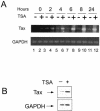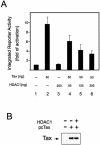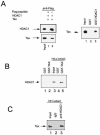Tax relieves transcriptional repression by promoting histone deacetylase 1 release from the human T-cell leukemia virus type 1 long terminal repeat
- PMID: 15194748
- PMCID: PMC421680
- DOI: 10.1128/JVI.78.13.6735-6743.2004
Tax relieves transcriptional repression by promoting histone deacetylase 1 release from the human T-cell leukemia virus type 1 long terminal repeat
Abstract
Expression of human T-cell leukemia virus type 1 (HTLV-1) is regulated by the viral transcriptional activator Tax. Tax activates viral transcription through interaction with the cellular transcription factor CREB and the coactivators CBP/p300. In this study, we have analyzed the role of histone deacetylase 1 (HDAC1) on HTLV-1 gene expression from an integrated template. First we show that trichostatin A, an HDAC inhibitor, enhances Tax expression in HTLV-1-transformed cells. Second, using a cell line containing a single-copy HTLV-1 long terminal repeat, we demonstrate that overexpression of HDAC1 represses Tax transactivation. Furthermore, a chromatin immunoprecipitation assay allowed us to analyze the interaction of transcription factors, coactivators, and HDACs with the basal and activated HTLV-1 promoter. We demonstrate that HDAC1 is associated with the inactive, but not the Tax-transactivated, HTLV-1 promoter. In vitro and in vivo glutathione S-transferase-Tax pull-down and coimmunoprecipitation experiments demonstrated that there is a direct physical association between Tax and HDAC1. Importantly, biotinylated chromatin pull-down assays demonstrated that Tax inhibits and/or dissociates the binding of HDAC1 to the HTLV-1 promoter. Our results provide evidence that Tax interacts directly with HDAC1 and regulates binding of the repressor to the HTLV-1 promoter.
Figures









Similar articles
-
Latency Reversing Agents: Kick and Kill of HTLV-1?Int J Mol Sci. 2021 May 24;22(11):5545. doi: 10.3390/ijms22115545. Int J Mol Sci. 2021. PMID: 34073995 Free PMC article. Review.
-
The interaction of HTLV-1 Tax with HDAC1 negatively regulates the viral gene expression.Oncogene. 2002 Oct 17;21(47):7241-6. doi: 10.1038/sj.onc.1205701. Oncogene. 2002. PMID: 12370815
-
SUV39H1 interacts with HTLV-1 Tax and abrogates Tax transactivation of HTLV-1 LTR.Retrovirology. 2006 Jan 13;3:5. doi: 10.1186/1742-4690-3-5. Retrovirology. 2006. PMID: 16409643 Free PMC article.
-
Histone deacetylase 3 represses HTLV-1 tax transcription.Oncol Rep. 2006 Sep;16(3):581-5. Oncol Rep. 2006. PMID: 16865259
-
The HTLV-1 Tax protein: revealing mechanisms of transcriptional activation through histone acetylation and nucleosome disassembly.Biochim Biophys Acta. 2010 Mar-Apr;1799(3-4):266-74. doi: 10.1016/j.bbagrm.2009.09.002. Epub 2009 Sep 25. Biochim Biophys Acta. 2010. PMID: 19782779 Review.
Cited by
-
Immunostimulation by induced expression of NKG2D and its MIC ligands in HTLV-1-associated neurologic disease.Immunogenetics. 2006 May;58(4):252-8. doi: 10.1007/s00251-006-0082-9. Epub 2006 Mar 28. Immunogenetics. 2006. PMID: 16568261
-
Regulation of HTLV-1 transformation.Biosci Rep. 2022 Mar 31;42(3):BSR20211921. doi: 10.1042/BSR20211921. Biosci Rep. 2022. PMID: 35169839 Free PMC article. Review.
-
Latency Reversing Agents: Kick and Kill of HTLV-1?Int J Mol Sci. 2021 May 24;22(11):5545. doi: 10.3390/ijms22115545. Int J Mol Sci. 2021. PMID: 34073995 Free PMC article. Review.
-
Human T-cell leukemia virus type 1 (HTLV-1) bZIP protein interacts with the cellular transcription factor CREB to inhibit HTLV-1 transcription.J Virol. 2007 Feb;81(4):1543-53. doi: 10.1128/JVI.00480-06. Epub 2006 Dec 6. J Virol. 2007. PMID: 17151132 Free PMC article.
-
Characteristics of Adult T-Cell Leukemia/Lymphoma Patients with Long Survival: Prognostic Significance of Skin Lesions and Possible Beneficial Role of Valproic Acid.Leuk Res Treatment. 2015;2015:476805. doi: 10.1155/2015/476805. Epub 2015 Jun 14. Leuk Res Treatment. 2015. PMID: 26199759 Free PMC article.
References
-
- Baranger, A. M., C. R. Palmer, M. K. Hamm, H. A. Giebler, A. Brauweiler, J. K. Nyborg, and A. Schepartz. 1995. Mechanism of DNA-binding enhancement by the human T-cell leukaemia virus transactivator Tax. Nature 376:606-608. - PubMed
-
- Bex, F., and R. B. Gaynor. 1998. Regulation of gene expression by HTLV-I Tax protein. Methods 16:83-94. - PubMed
-
- Brady, J. N. 1996. Biology of HTLV-I: host cell interactions, p. 79-112. In P. Hollsberg and D. A. Hafl (ed.), Human T-cell lymphotropic virus type I. John Wiley and Sons Ltd., Chichester, England.
MeSH terms
Substances
LinkOut - more resources
Full Text Sources
Miscellaneous

